To get a puppy 🐕 or dog to stop jumping on me, I would ignore the dog’s jumping and reward calm behavior. Of course, that’s more difficult than it sounds, so I’ll give you some ideas on how to actually do this.
Why do dogs jump on you?
If your dog or puppy is jumping on you, all it usually means is your dog is seeking attention. It works! Most people pet, talk to or kneel down and acknowledge a dog that jumps.
And even if the person tries to hold the dog’s collar or push the dog away, most dogs still see this as good attention! Yay, this person is paying attention to me!
Just because your dog is jumping on people doesn’t mean you have a “bad” dog or that your dog thinks he’s “the boss.”
Dogs are simply acting in the moment and most of the time they just don’t understand the rules. This is why almost all puppies jump and nip at people a lot!
Remember, it’s NORMAL for a dog or puppy to jump, unfortunately. That’s what dogs do with each other!
However, we need to teach them that this behavior is not appropriate towards people. We don’t want them knocking over grandma or your 3-year-old nephew.
IN THIS ARTICLE:
- Ignore your dog to stop the jumping
- Act like a tree to stop your puppy’s jumping
- Correcting your dog from jumping
- Kneeing the dog in the chest to stop jumping
- Stop a dog’s jumping with the Doggie Don’t Device
- How to stop a dog from jumping using an e-collar
I’m using “dog” and “puppy” in this article because the same basic idea applies to stop either a dog or a puppy from jumping.
How to stop my dog 🐶 from jumping on me
The following are my tips to stop a dog from jumping.
My dog Remy jumps on me occasionally during his “wild” spells. He leaps up and nips, bounces off of me, then tears around the room. He grabs a toy, growls and play bows, then charges and jumps again.
Thankfully, this only happens once a month or so now that he’s 5 years old. But when he was younger, he would do this multiple times per day!
Remy’s jumping habit was related to his high energy and excitement level. He was just playing, even though I did not particularly appreciate that sort of play!
So here are some ideas to try to stop your dog from jumping on you or others.
1. Ignore your dog to stop him from jumping
The best thing to do is not give the dog or puppy any attention for jumping.
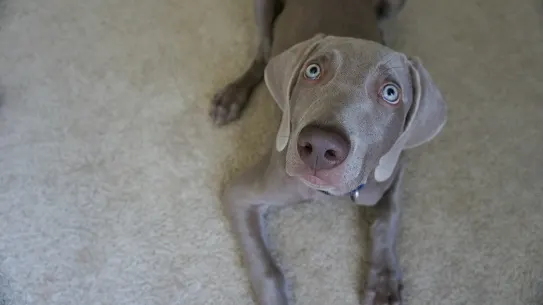
It seems like everyone knows they should ignore a dog for jumping, but people don’t have a good sense of what “ignoring” truly means!
How to truly ignore a jumping dog or puppy
- Show no emotion of any kind
- Don’t scold your dog
- Do not look at your dog
- Don’t talk to your dog or laugh at your dog (don’t even smile)
- Do not touch your dog or interact in any way
- Focus on something else such as your phone, even if you’re pretending (Dogs use this tactic with each other!)
What you need to do is basically become like a zombie – no emotion. You’re not angry or excited or stressed. Stare at your phone or the TV or focus on someone else.
It’s hard! But stay relaxed and calm and act as if the dog is not there.
This means no laughing at his cuteness. No scolding. Don’t even look at him. Just calmly walk right into him if he’s jumping as you go about your business. Pretend to be really interested in the dishes or going through the mail or whatever.
If the dog keeps jumping on you, calmly leave
If the dog continues to jump on you even as you ignore him, calmly leave the room, step over a baby gate or sit on a tall stool that’s out of the dog’s reach.
Return once the dog is calm, could be 30 seconds or a few minutes.
Sometimes they will do something else to get your attention like try to rip up a rug or grab your shoes if you continue to ignore them.
If that happens regularly, then instead of you leaving the room, you should quietly guide your dog into his kennel or into a smaller room like the laundry room for a quiet “timeout.” Don’t do this as a punishment but more of an emotionless, “well, too bad.”
Invite him back again when he is calm.
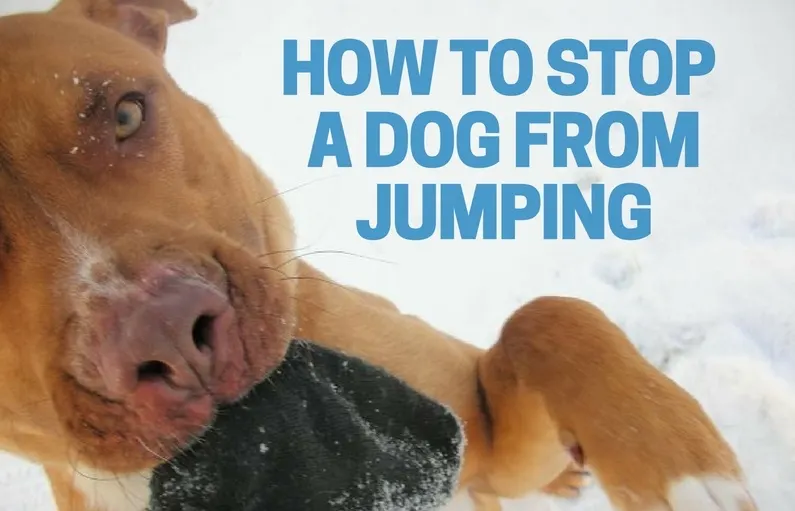
Older dogs ignore younger dogs that are jumping and biting
Older dogs will ignore puppies when they don’t want to play with a young, jumpy pup. They will often pretend to focus on a “smell” in the grass. Pretty soon the pup is also interested in sniffing the grass or he gets bored and finds something better to do.
*Enjoying this article? Get realistic dog training tips emailed once a week. Click Here
2. Act like a “tree” to stop my dog from jumping on me
Some dog trainers will say to “be a tree” to ignore the jumping. Then reward the puppy when all four paws are on the ground. What they mean is you should simply turn your back and stand still if a dog jumps. Don’t interact at all.
This is good advice, and it’s generally what I was trying to say above. Just go about it in the right way.
You don’t want to be spinning and spinning as your dog runs in circles around you. This ends up getting the dog more wound up.
Instead, don’t engage at all, which means you might have to take a few “punches” and scratches. That’s why I like the approach of moving to a tall stool or calmly leaving the room if you have to.
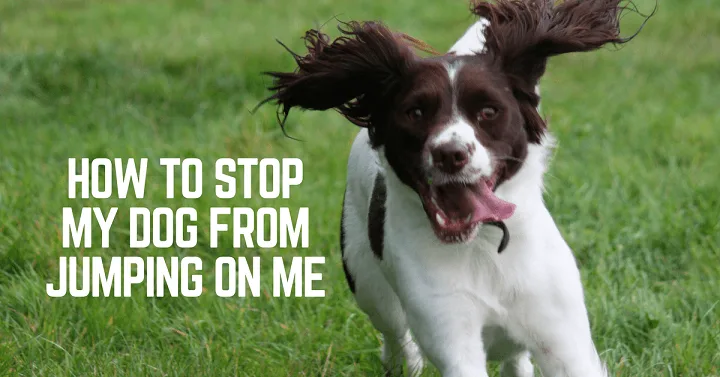
Jumping on you has worked to get attention in the past, so your dog is going to keep trying this.
If you give in and scold him or try to push him away, he’s going to learn he can still get your attention for jumping. So hang in there! It takes a lot of discipline, practice and patience to truly ignore them.
If you ignore your dog for jumping (truly ignore), eventually the behavior should decrease.
Here is a video I made where I talk about setting rules to stop your dog’s jumping and more:
3. Give attention when the puppy is calm.
We often focus on what we don’t want our dogs to do and forget to reward them for good behavior.
So, when your dog is not jumping on you during a greeting, reward him with a calm “gooood boooy” or tossing a treat.
Be calm yourself. Make sure you’re not unintentionally encouraging jumping through your behavior and body language.
Don’t laugh at your dog or talk to him when he jumps. And, don’t get him excited again with your praise. Keep a calm, slow voice and pet him slowly.
4. Carry treats to reward calm behavior.
I recommend Wellness Well Bites for training treats because they are small and soft and dogs love them! Wearing a treat pouch to hold the treats is also helpful, vs. stuffing them in your pockets.
You can use treats to reward your dog when you notice calm behavior.
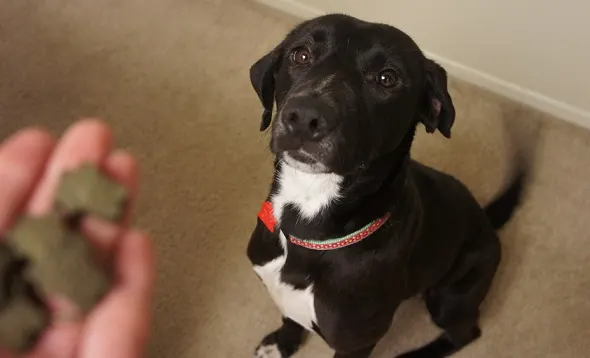
Our foster dog, Lana
I will give a treat to Remy when I see he has chosen to remain lying down or sitting rather than jumping.
Another option: Hand your dog a chew toy or bully stick.
This can work well when people visit. Some dogs will take a bully stick and retreat to their bed for some chew time. A bully stick might last some dogs up to 20 or 30 minutes.
Of course, some dogs will just get more riled up and run around with their “prize” so you have to know your dog.
5. Have a plan – decide on your rules.
It’s important to decide your own rules and be consistent. If you don’t know what is “allowed,” how is your dog supposed to know? All family members and roommates should be on board with the same rules.
For example, I don’t mind if my dogs run up and greet me at the door and show excitement. I like that. However, I do expect them to settle down shortly afterwards, and I do not allow any barking or jumping during greetings. Your rules might be a little different.
We discussed this in my post on how to keep a dog calm around visitors.
It’s not enough to want your dog to stop jumping. You have to decide what you want him to do instead. Lie on a bed? Sit next to you? Calmly greet people without jumping?
Then figure out how to make this happen, and practice it. Dogs need lots and lots of repetitions in order for a concept to stick, especially with something as challenging as not jumping on visitors.
6. Keep your dog on a leash to prevent jumping.
You can use your dog’s regular leash as a tool to help in situations where you know your dog is likely to jump – such as at the door.
I will step on the leash if necessary to stop a dog from jumping. You can also just hold the leash so he’s under control.
His usual training collar will also help, no matter what type of tool you normally use. My dog is much calmer when he wears his Gentle Leader, for example. This is the tool that fits over a dog’s muzzle. It’s designed to stop them from pulling.
Another good option is to use an extra short traffic leash or “leash tab.” This is a short leash 10″ or so.
It’s helpful because if your dog wears it, it won’t drag around as long as a normal leash, catching on things. Then, when people are at the door, you can easily reach down and hold the leash tab to control your dog.
7. Instruct guests to ignore your puppy.
I’ve found that people don’t really ignore my dog when I ask them to unless I give very specific instructions such as “do not look at him or acknowledge him at all.”
“If he whines, don’t look at him or talk about him,” I say. “If he comes up to you, just keep on walking like he’s not there.”
8. Practice LOTS of obedience training with your dog.
We should all be practicing basic obedience with our dogs every day and then slowly looking for more challenges. If a dog is not able to lie down and stay with no distractions, then of course he won’t be able to do this during an exciting situation like when 3 people come to the door!
And of course, don’t hesitate to hire a trainer. It’s worth the money if it decreases your stress!
9. Increase your dog’s exercise.
60 to 90 minutes of physical exercise every single day is the minimum for an active breed.
When I take my dog Remy running consistently, he does not jump on me. If we miss a day, he’s more likely to jump because he has extra energy. Drain their energy in other ways and they’ll have an easier time remaining calm.
Increasing your dog’s exercise won’t magically fix your problems but the less pent-up energy your dog has, the better! Try longer walks with a dog backpack.
Try running with your dog and giving him plenty of off-leash time to burn up energy.
See our post: Exercise ideas for dogs.
You can also give your dog puzzle toys to drain mental energy such as a Kong with frozen peanut butter. Or play some games like “find it” where you hide treats or dry dog food.
Should you correct your 🐕 dog for jumping?
“Correcting” or “punishing” a dog from jumping could mean several things such as:
- Telling the dog no
- Squirting the dog or puppy with water
- Physically blocking the dog (“body block”) or lifting up a knee
- Using a training tool such as an e-collar
I’m not saying you should or shouldn’t correct your dog for jumping. I’m going to let you decide what is best for your own dog.
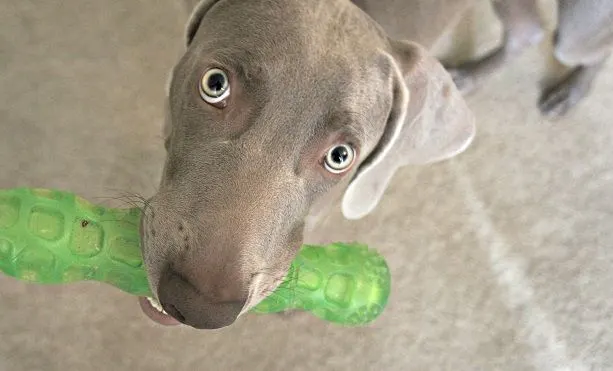
1. Use a firm “NO” to stop my dog from jumping on me
I know some trainers will tell you never to tell a dog or puppy “no.” I think that is silly.
I use “no” or “uh-uh” to let my dog know that his current behavior is not appropriate. I save the hard, aggressive “NOOO!!” for something truly bad or dangerous.
By the way, I also use the marker word “good” when he does something good!
Telling a dog “no” is a good way to communicate to them that their behavior is not appropriate. For me, it’s not meant as a punishment but a way to say “no, don’t do that” and then reward a more appropriate behavior, like sitting.
2. Squirt the dog with water when he jumps.
This is another option that works for some dogs. Others (like mine) think this is a fun game. You can get a cheap water bottle for $1 just about anywhere. You would give a quick squirt to interrupt the jumping. Then praise.
3. What about kneeing the dog in the chest?
Oh the horror! Call PETA!
I’m not saying you should forcefully jam your knee into the dog’s chest to cause pain. Instead, calmly raise your knee to block the dog as you move forward. It tells the dog, “Respect my space.”
Then pet the dog when he’s calm.
I do not mean you should forcefully knee a dog in the chest. This could hurt the dog. Just stick your knee out to block the dog.
That being said, if you see a large dog charging you, I’d rather you use your knee or foot in self defense than to lean backward or back away.
Backing away is a good way to encourage the dog to jump on you, possibly knocking you over. It’s a good way to get hurt.
Instead, I recommend you stay calm, hold your ground and move forward with your knee or hip out.
It is also effective to yell “No!” while you stand up straight, point at the dog and move into “his” space. Usually this at least stops the dog in his tracks for a second, which is enough to stop him from crashing into you at full speed.
He may still jump on you, but at least he’s not going 90 mph.
If you are the owner of a dog that jumps, please don’t put people in a position where they feel like they have to either pet your dog or push him away. Keep him leashed while he’s still learning so he can’t hurt or annoy anyone.
See my post: The time I kicked an aggressive dog
4. Use a tool such as an e-collar.
Sometimes the best thing is to use a tool to stop a dog’s jumping for a split second so you can reward your dog for sitting or standing.
For example, the Pet Corrector blasts air at the dog and the Doggie Don’t Device makes a loud, static noise. You could also try an e-collar with a remote. When all four paws are on the ground, he gets praise.
Now for those interested, I’ll get into some details on how to use the product called the Doggie Don’t Device.
Stop my dog from jumping on me using an e-collar
To stop a dog from jumping, ignoring them is a great idea. The problem is, a lot of dogs don’t have the self-control not to jump when they’re excited, and people are not always consistent with which behaviors they reward!
That’s why for certain “bad” behaviors, it’s helpful if you can interrupt your dog just for a second—long enough to stop the “bad” behavior—and then praise.
As I mentioned, tools that can help with this are:
- simple squirt water bottle
- the Pet Corrector
- Doggie Don’t Device
- e-collar
I recommend keeping it as simple as possible and simply trying a squirt bottle of water first. Then the Pet Corrector is a good option. It simply makes a noise as it shoots out compressed air.
Another option is the Doggie Don’t Device:
The Doggie Don’t is simple to use and makes a LOUD, static noise. I personally hate the noise myself so I don’t like using this tool. It hurts MY ears!
But it does help to interrupt the behavior for some dogs. Then, you praise them for calm behavior like sitting or standing.
E-collars to stop a dog’s jumping
If you go this route, you want to invest in a high-quality brand such Sport Dog and practice getting used to the tool without your dog around first.
Always test the correction levels on your own skin as well, so you know what your dog might be feeling.
E-collars are certainly not for everyone and most people won’t need one to stop a dog from jumping. I simply wanted to mention this option for those interested.
Here is my long article on how I trained my dog to come when called using a Garmin e-collar.
How to stop your dog from jumping on the furniture
There’s nothing wrong with allowing your dog to jump up on the furniture such as the couch, a chair or your bed … as long as YOU decide this is OK. The dog does not get to decide!
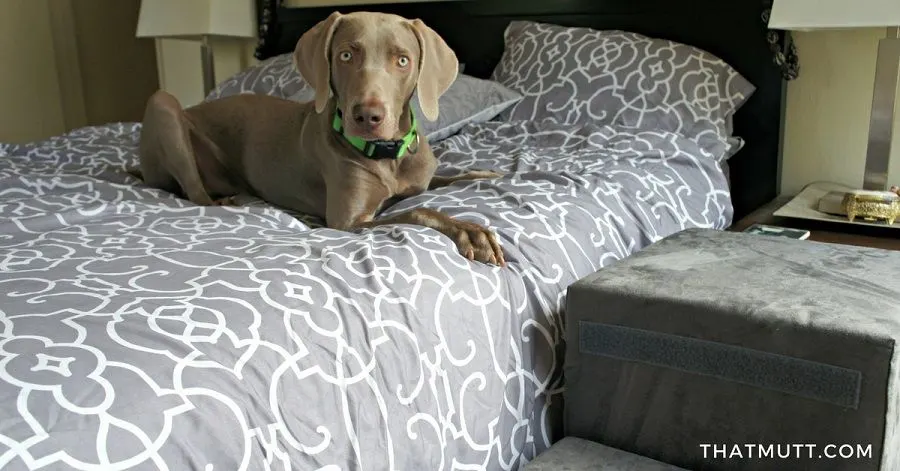
If you do not want to allow your dog on the furniture, then it’s best NEVER to let your dog on the furniture, starting from when they are puppies.
If your dog is already used to being on the couch or your bed, then it’s not too late to train him.
Simply be consistent!
Use a word like “off” and remove your dog from the couch or bed. Reward your dog for sitting on the ground or on a dog bed. If your dog jumps onto the bed again, simply say, “No, off” and remove him.
You might have to do this five or six times with stubborn dogs. If your dog just keeps on trying, then block access to that room or put him on a leash.
Block your dog from the furniture when home alone.
When you are at work or when you can’t supervise your dog, I recommend you block your dog’s access to the furniture that is off limits.
This might mean you have to use a kennel/crate for your dog. Or, it might mean you need to keep your dog on a leash and near you when you’re working from home. Or even use a dog daycare temporarily.
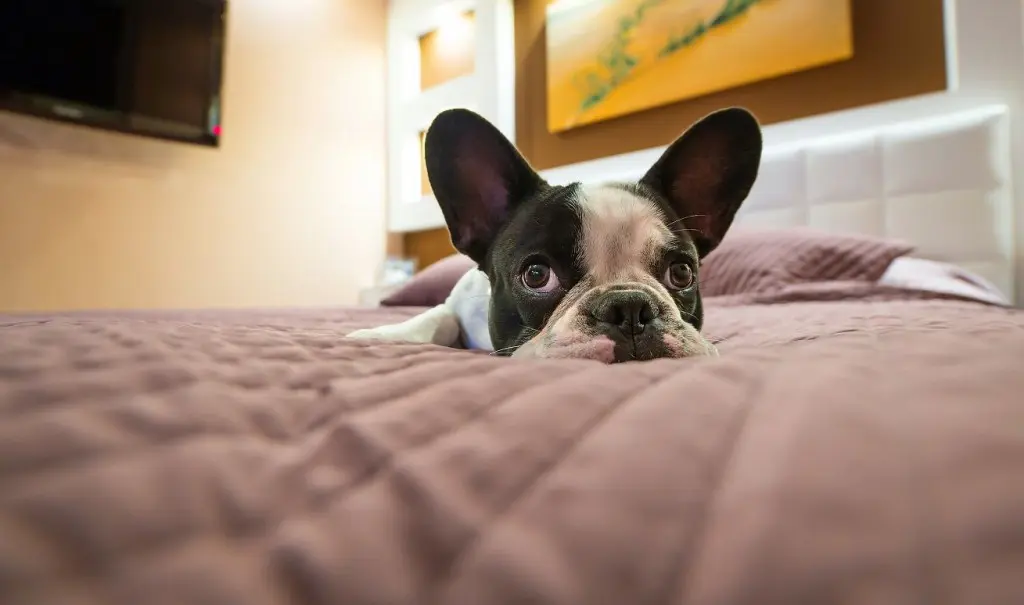
If a dog is blocked from the furniture for long enough, they typically change their habits. Remember to reward your dog for lying on the floor or on their comfy dog bed.
See our posts:
- How to keep dogs off the furniture
- Stop my dog from growling at me on the bed
- Teach your dog to go to his bed
OK, I’d like to hear your take on all of this.
Does your dog jump on people? What did you do to stop the jumping?
Don’t hesitate to reach out to a trainer if you need some help to keep everyone safe.
(Note that it’s normal for all puppies to jump and nip. Don’t be overly concerned if your puppy is doing this.)
*If you would like to receive our FREE down-to-earth, weekly dog training tips, Click Here
Best Training Products to Stop a Dog’s Jumping:
- Wellness Well Bites Treats.
Wellness treats are treats almost all dogs are willing to work for and focus on! - Treat bag.
Carry your treats in a convenient treat pouch around your waist so you’re always ready to reward your dog when he’s calm with all four paws on the ground. - Bully Sticks.
Having a high-valued chew like a bully stick on hand can help your dog settle down and focus on something else for several minutes.
Additional resources:
- Stop my small dog from guarding me.
- How to stop a puppy from biting
- How to get your hyper dog to relax
- Help! My dog is out of control!
Get all of our training tips HERE.
Lindsay Stordahl is the founder of That Mutt. She writes about dog training, dog exercise and feeding a healthy raw diet.

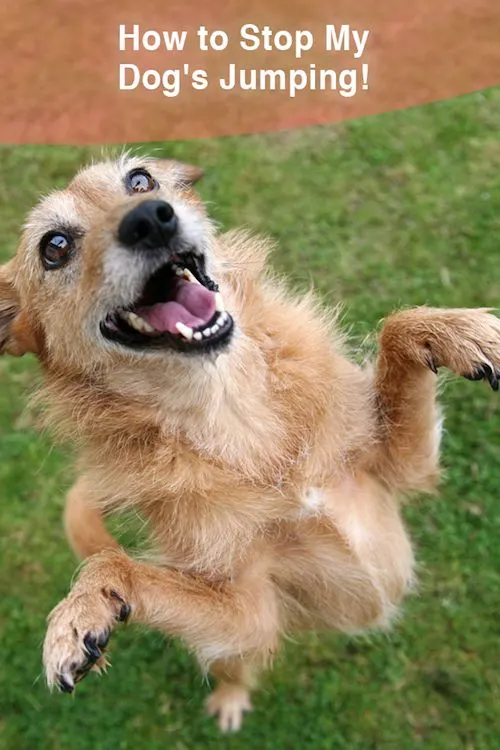
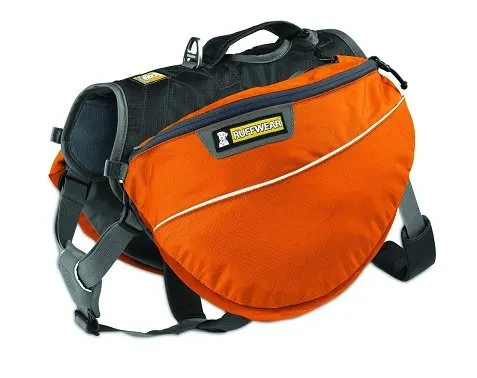
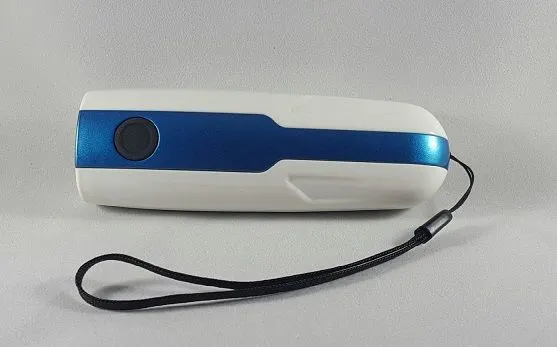
Jeri
Sunday 31st of July 2022
I had an adult (about 5 years old) rescue rat terrier/chi mix that was a jumper. I used #6 - step on the leash. First time I did it & she tried to jump, she face planted on a tile floor & knocked out a tooth. We never did that correction again......
Bonnie's Human
Wednesday 23rd of February 2022
As a kid i had a friend whose parents would always have a sheet of tin foil spanned across their couch cushion in their living room. I was baffled when they explained to me it was to keep the dogs off the sofa. Might be worth trying so i figured id put it here. (P.S. when humans went to sit on the sofa they would remove the tin foil and place it back once they stood up. For the record)
Kara Luker
Sunday 2nd of January 2022
Our puppy get so excited when people come and has regressed in this area so I needed these reminders! Thanks for the post!
L
Sunday 24th of October 2021
I don’t think dogs are being disrespectful with play nibbles. Just needs correction. It’s a natural dog behavior. As is jumping.
L
Sunday 24th of October 2021
I have a small dog. Decided I liked the jumping. I could ignore it and he’d stop but I feel like it’s the best. It may be harder and painful with a bigger dog